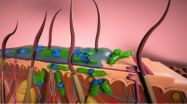EPO: Protecting the brains of very preterm infants
2014-08-26
(Press-News.org) Premature babies are far more at risk than infants born at term of developing brain damage resulting in neurodevelopmental delay that may persist throughout their lives. A team of specialists in infant brain imaging from the Faculty of Medicine at the University of Geneva (UNIGE) and the University Hospital of Geneva (HUG) has demonstrated the following: administering three doses of erythropoietin – a hormone that stimulates the formation of red blood cells – immediately after birth significantly reduces brain damage in babies. The results are available in more detail in the Journal of American Medical Association (JAMA).
Nearly 400,000 children are born in Europe every year before the 32nd week of pregnancy (and 2.6 million worldwide, according to the World Health Organisation), including around 80 at HUG. There are numerous health implications for children who are born so prematurely, including brain damage and incomplete maturation of the brain, especially the white matter responsible for propagating information in the nervous system. New imaging techniques, including magnetic resonance imaging (MRI) – a non-invasive method with no radiation exposure – make it possible to identify brain damage at an early stage that could have long-term consequences on a child's development: including motor and cognitive problems, attention and learning difficulties leading to loss of human capital .
EPO: a well-known hormone
Synthetic erythropoietin (EPO) – whose doping effects amongst athletes are well-known – is a treatment commonly used to prevent anaemia; it is also used in preterm infants, as it reduces the need for blood transfusions. A number of recent studies have shown that the same hormone also has a neuroprotective effect. The Geneva team, led by Petra Susan Hüppi, professor in the Faculty of Medicine at UNIGE and head of the Division of Development and Growth in the Department of Paediatrics at HUG, set out to verify the impact of EPO on premature babies brain. They reviewed the MRI scans of 165 children, half of whom had received three doses of EPO within two days of birth. "We found that the brains of the children who had received the treatment had much less damage than those in the control group, who had been given a placebo," explains Russia Ha-Vinh Leuchter, co-author of the study: "This is the first time that the beneficial effect of the EPO hormone on the brains of premature babies has been shown."
The first chapter in a nationwide study
The research is led by Geneva and forms part of an extensive Swiss study carried out in cooperation with the University of Zurich, covering 495 children born in Switzerland between 2005 and 2012. The second – and main – part of the work will focus on the neurocognitive development of these children, who will take part in various developmental tests at the age of two and five years. As professor Petra Hüppi explains: "State-of-the-art developmental testing as performed in our Swiss Developmental Pediatric units should confirm the effect that EPO treatment has on the neurodevelopmental disabilities that very premature babies often show during their infancy." The professor concludes: "If this does turn out to be the case, we will have taken an important step in preventing brain damage and its longterm consequences in premature babies." The main findings of the study, therefore, are yet to come.
INFORMATION:
ELSE PRESS RELEASES FROM THIS DATE:
Collaborative care improves depression in teens
2014-08-26
SEATTLE—How best to care for the many adolescents who have depression? In a collaborative care intervention, a care manager continually reached out to teens—delivering and following up on treatment in a primary-care setting (the office of a pediatrician or family doctor, not a psychiatrist or psychologist) at Group Health Cooperative. Depression outcomes after a year were significantly better with this approach than with usual care, according to a randomized controlled trial published in JAMA.
Depression is common in adolescents: Up to one in five have major depression ...
Attacking a rare disease at its source with gene therapy
2014-08-26
PHILADELPHIA — Treating the rare disease MPS I is a challenge. MPS I, caused by the deficiency of a key enzyme called IDUA, eventually leads to the abnormal accumulation of certain molecules and cell death.
The two main treatments for MPS I are bone marrow transplantation and intravenous enzyme replacement therapy, but these are only marginally effective or clinically impractical, especially when the disease strikes the central nervous system (CNS). Using an animal model, a team from the Perelman School of Medicine at the University of Pennsylvania has proven the efficacy ...
Unprecedented detail of intact neuronal receptor offers blueprint for drug developers
2014-08-26
Argonne, Ill.– Scientists succeeded in obtaining an unprecedented view of a type of brain-cell receptor that is implicated in a range of neurological illnesses, including Alzheimer's disease, Parkinson's disease, depression, schizophrenia, autism, and ischemic injuries associated with stroke.
The team of biologists at Cold Spring Harbor Laboratory used the U.S. Department of Energy's Advanced Photon Source at Argonne National Laboratory to get an atomic-level picture of the intact NMDA (N-methyl, D-aspartate) receptor should serve as template and guide for the design ...
Yale journal explores advances in sustainable manufacturing
2014-08-26
In recent years, increasing pressure from policymakers, consumers, and suppliers has prompted manufacturers to set environmental targets that go beyond reducing the pollutants they emit from their smokestacks or discharge into rivers and lakes. Today companies must also assess environmental performance at every step in their process, from the mining of primary materials to the use and recycling of their products.
This perspective has given rise to the discipline known as life cycle engineering, which connects the engineers who grapple with the efficiencies of production ...
Composition of Earth's mantle revisited
2014-08-26
Research published recently in Science suggested that the makeup of the Earth's lower mantle, which makes up the largest part of the Earth by volume, is significantly different than previously thought.
Understanding the composition of the mantle is essential to seismology, the study of earthquakes and movement below the Earth's surface, and should shed light on unexplained seismic phenomena observed there.
Though humans haven't yet managed to drill further than seven and a half miles into the Earth, we've built a comprehensive picture of what's beneath our feet through ...
What can 14th century Venice teach us about Ebola and other emerging threats?
2014-08-26
The way in which the Italian city of Venice dealt with the outbreak of the plague in the fourteenth century holds lessons on how to even mitigate the consequences of today's emerging threats, like climate change, terrorism, and highly infectious or drug-resistant diseases. So says Dr. Igor Linkov of the US Army Engineer Research and Development Center, and a visiting professor of the Ca Foscari University in Italy. Linkov led an article on resilience management appearing in Springer's journal Environment Systems and Decisions.
Venice was the hub of many trade routes into ...
Sorting cells with sound waves
2014-08-26
CAMBRIDGE, MA -- Researchers from MIT, Pennsylvania State University, and Carnegie Mellon University have devised a new way to separate cells by exposing them to sound waves as they flow through a tiny channel. Their device, about the size of a dime, could be used to detect the extremely rare tumor cells that circulate in cancer patients' blood, helping doctors predict whether a tumor is going to spread.
Separating cells with sound offers a gentler alternative to existing cell-sorting technologies, which require tagging the cells with chemicals or exposing them to stronger ...
Introducing the multi-tasking nanoparticle
2014-08-26
(SACRAMENTO, Calif.) — Kit Lam and colleagues from UC Davis and other institutions have created dynamic nanoparticles (NPs) that could provide an arsenal of applications to diagnose and treat cancer. Built on an easy-to-make polymer, these particles can be used as contrast agents to light up tumors for MRI and PET scans or deliver chemo and other therapies to destroy tumors. In addition, the particles are biocompatible and have shown no toxicity. The study was published online today in Nature Communications.
"These are amazingly useful particles," noted co-first author ...
HIV antibodies block infection by reservoir-derived virus in laboratory study
2014-08-26
WHAT:
A laboratory study led by scientists from the National Institute of Allergy and Infectious Diseases, part of the National Institutes of Health (NIH), lends further weight to the potential effectiveness of passive immunotherapy to suppress HIV in the absence of drug treatment. Passive immunotherapy for HIV is an experimental strategy that involves periodically administering broadly neutralizing HIV-specific antibodies (bNAbs) to control the virus. It would be advantageous to control HIV without antiretroviral drugs because of their cost, the potential for cumulative ...
Breakthrough antibacterial approach could resolve serious skin infections
2014-08-26
Like a protective tent over a colony of harmful bacteria, biofilms make the treatment of skin infections especially difficult. Microorganisms protected in a biofilm pose a significant health risk due to their antibiotic resistance and recalcitrance to treatment, and biofilm-protected bacteria account for some 80 percent of total bacterial infections in humans and are 50 to 1,000 times more resistant to antibiotics than simpler bacterial infections.
"In essence, we may have stumbled onto a magic bullet," said David Fox, a Los Alamos National Laboratory researcher on the ...


